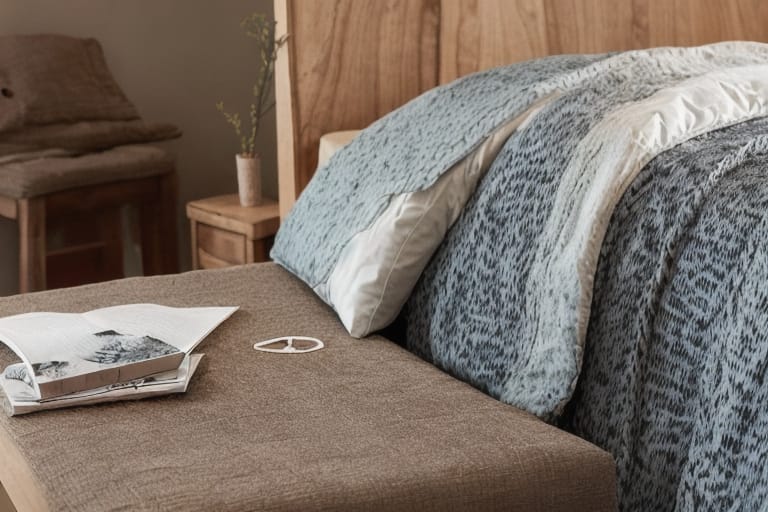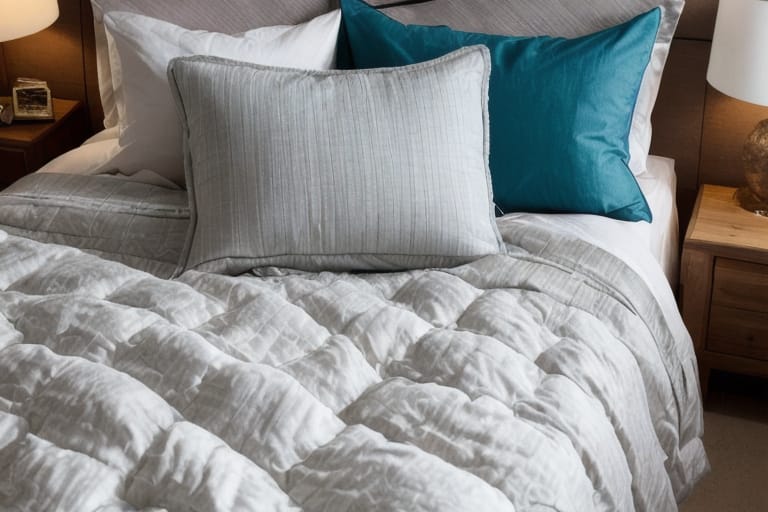Have you ever wondered, when snuggling under a down comforter on a cold winter night, if what’s keeping you so blissfully warm comes from feathers? There’s often confusion over what exactly is inside that fluffy comforter. Is it fine feathers, fluffy down, or something else entirely?
Understanding the fill inside your comforter helps ensure you pick the perfect bedding for warmth, comfort, and even allergy needs. In this beginner’s guide, we’ll unravel the mysteries around down and feather fill so you can learn exactly what fills your comforter.
What’s Inside a Down Comforter?
Down comforters consist of an outer fabric shell or cover stuffed with a fluffy down fill inside. But what is down? And how does it differ from feathers?
Down refers to the soft, fluffy undercoating found beneath the exterior feathers and wings of ducks and geese. Down clusters don’t have quills so they offer fine, thermal insulation without prickliness.
Feathers have quills or stems so they can feel stiff and poke through bedding. Some down comforters add small amounts of feathers for fill, but higher-end comforters use primarily down.
The Impact of Fill Power on Warmth and Puffiness
The warmth, loft, and puffiness of a down comforter depends largely on its fill power. Fill power rates the quality and insulation capacity of down, ranging from about 300 up to 900.
Higher fill power down around 700-900+ will have:
- Greater loft and puffiness from more down clusters
- Better warmth from finer, more efficient insulation
- Light and airy feel yet capacity to trap body heat
Lower grades around 300-500 fill power still warm well, just with less loft and air pockets to capture heat. Higher fill downs last longer too.
| Fill Power | Quality | Benefits |
|---|---|---|
| 300-400 | Low | More affordable from small, broken clusters |
| 600-700 | Middle | Balances cost with good loft and durability |
| 800-900+ | Premium | Investment in long-lasting, cloud-like warmth |
Why Down Offers Superior Cozy Warmth
The reason down makes such an exceptionally warm, comforting fill goes back to science. The tiny down clusters create:
- High loft or “fluffiness” from the 3D structure trapping lots of insulating air pockets.
- Breathability unlike bulky synthetics, with airflow preventing overheating.
- Quick drying since down lacks absorbing quills unlike feathers.
- Lightweight, fine fill unlike heavy alternatives like cotton or wool.
This winning combination offers cloud-like coziness yet breathability perfect for comforters. The more fill power, the better the performance. 800-fill down can insulate nearly three times more than an equal weight of 600-fill!
“Higher fill powers create exponentially more insulation value from the fine clusters and loft.” – Martha Stewart
How Fill Composition Impacts Allergies
Allergies come into play a lot in bedding choices. But can down comforters work for allergy sufferers? Or do feathers create issues?
Down itself is hypoallergenic, meaning the fluffy fill doesn’t trigger allergies. Feathers, however, have protruding quills that can poke through fabric over time. This allows ingress of irritating dust mites.
That’s why quality manufacturers use reinforced fabrics with tight weaves (typically 300+ thread count cotton sateen or cotton/microfiber blends). This helps block allergens like dust mites or pet dander from invading the interior. Some even add antimicrobial treatments.
For optimal allergy protection, choose comforters with 100% hypoallergenic down free of feathers. This avoids quill concerns altogether while offering cleaner fill.
How to Evaluate the Durability of a Down Comforter
Investing in a down comforter often means paying more up front. But you’ll be rewarded over time with exceptional long-lasting comfort.
Factors impacting the lifespan and durability of a down comforter include:
Shell Fabric
- Tightly woven fabrics prevent fill leakage so loft stays even and lasting.
- Materials like 300-600 thread count cotton sateen prove most durable over years of use.
- Reinforced edge piping adds structure integrity too.
Fill Power
- As mentioned, higher fill power down around 700-900+ lasts significantly longer than lower grades.
- You get what you pay for with fewer broken clusters and collapsing.
Stitching & Baffles
- Smaller quilted boxes (known as baffles) keep fill evenly distributed.
- Look for precision double needle stitching that won’t loosen or pop.
Choosing the best combination of shell attributes and fill quality means fewer cold spots or shifting issues over 3-10+ years of use.

Pros and Cons of Down vs. Down Alternative Comforters
While down reigns supreme for warmth and comfort, allergy sufferers may need to consider synthetic down alternatives. What are the differences?
| Down Comforters | Down Alternative Comforters |
|---|---|
| Pros | Pros |
| – Exceptional warmth from loft trapping body heat | – Hypoallergenic, no dust mite allergens |
| – Light, airy pillowy feel | – Stays fuller longer vs. natural down |
| – Packs down for storage | – Machine wash and dry with ease |
| – Long-lasting over years | – More budget-friendly pricing |
| Cons | Cons |
| – Allergens like dust mites possible | – Synthetics lack breathability of down |
| – Needs professional cleaning | – Retains more moisture than down |
| – May shift during washing | – Not as warm due to less loft |
The takeaway? Down alternatives work well for allergy issues, easy care, and budgets. But down still wins for cloud-like comfort and sleeping climate. Hybrid down-alternative comforters offer a middle ground too.
Finding the Right Warmth Level for You
Beyond fill composition, it helps to pick the right warmth level or tog rating for your needs. This indicates the insulation capacity. Choices usually range from lightweight summer to ultra-warm winter options:
| Warmth Level | Tog Rating | Best Uses |
|---|---|---|
| Lightweight | 4-7 tog | Warm summer nights |
| All-season | 7-12 tog | Spring and fall comfort |
| Extra warmth | 13-15+ tog | Cold winter insulation |
Consider your room temperature, climate and whether you sleep hot or cold naturally before deciding. Those who get hot and sweaty at night may want a lighter 7-9 tog comforter for sufficient warmth without overheating.
Top 5 Down Comforters of 2023
Ready to sink into a cozy nest of down? Here are five of the top-rated down comforters for 2023 based on testing criteria like warmth, fill power, shell durability and overall value:
1. Royal Hotel’s Extra Warmth White Goose Down Comforter
- Rating: 9.7/10
- Price: $$$
- Fill Power: 750
- Special Features: Corner loops to anchor duvet, Egyptian cotton cover
Delivering hotel collection luxury, this high fill power reversible comforter provides cloud-like softness and lightweight warmth perfect for cold climates.
2. Puredown Clean-Certified White Down Comforter
- Rating: 9.5/10
- Price: $$
- Fill Power: 600
- Special Features: OEKO-TEX certified clean fill, PermaFresh odor control
An exceptional mid-range priced option, this comforter offers great year-round warmth with allergy-friendly clean certified down inside a 400 thread count cotton shell.
3. Basic Beyond’s Warm Synthetic Down Alternative Comforter
- Rating: 9.3/10
- Price: $
- Fill Type: Gel fiber down alternative
- Special Features: Corner tabs, ties to duvet cover
For a quality budget pick that’s easy to care for, this reversible down alternative comforter offers hotel-style comfort without feathers or allergy issues.
4. White Goose Feathers Siberian Goose Down Comforter
- Rating: 9.2/10
- Price: $$$$
- Fill Power: 900+
- Special Features: 100% goose down, medium warmth great for all seasons
The ultimate in luxury comfort with oversize baffles stuffed with pure high fill power Siberian goose down. Worth the investment!
5. LOFTEX’s Affordable Lightweight Down Comforter
- Rating: 8.9/10
- Price: $
- Fill Power: 550
- Special Features: Corner loops, machine washable
For a super budget-friendly starter down comforter, this summer-weight option still delivers quality construction, handy corner tabs and easy care under $100.
See our top down comforter picks spanning budget to luxury options.
Caring for a Down Comforter
To keep your down comforter at peak coziness for years, certain care is key:
- Covering protects from body oils and stains between washings.
- Fluffing frequently maintains maximum loft and air space for warmth.
- Dry cleaning is ideal to clean most down comforters. Home washing risks clumping.
- Air dry if home washing rather than high heat drying to preserve down quality.
- Annual cleaning boosts fill performance and ensures good hygiene.
- Off-season storage when not needed helps down recover loft after packing down.
Review any specific washing guidance from the manufacturer too. With proper care, a quality down comforter should deliver dreamy comfort for 5-10 years or longer.
The Takeaway − Enjoy the Blissful Warmth of Down!
There’s simply nothing like sinking into the lightweight yet substantial warmth of a down-filled comforter. Now that you know what down actually is in a comforter versus feathers, you can better select the ideal fill power, warmth and shell fabric to suit your budget.

Frequently Asked Questions About Down Comforters
What exactly is the fill inside my down comforter?
Down comforters are filled with the amazingly warm and lightweight undercoating beneath the feathers and wings of ducks and geese. This soft undercoat is known as down. Higher quality comforters have less feathers which can feel stiff and poke through the fabric over time.
How does the fill power impact my down comforter?
The warmth, puffiness and durability of your down comforter depends on the fill power rating. Premium 800-900+ fill power down comes from larger clusters offering greater loft to capture more heat. It also lasts significantly longer through years of use and cleaning compared to lower 300-500 grades.
Is a down comforter hot for summer sleeping?
Great question! The breathable nature of down makes it uniquely suited for year-round comfort. Lightweight comforters with lower warmth ratings around 4-8 tog provide cozy insulation for summer without getting overly warm. Look for fill power around 600-650; perfect for heat regulation in warmer weather.
Can people with feather allergies use down bedding?
Absolutely! In fact, the down fill itself inside high-quality comforters is hypoallergenic meaning it won’t trigger allergies or reactions. Just be sure any small feather quill shafts are kept fully contained by a tight woven, high thread count fabric shell. Responsibly sourced white goose down proves ideal for allergy sufferers.
Is professional dry cleaning necessary to clean my down comforter?
To safely clean most down comforters without risking damage, dry cleaning by a professional is definitely recommended every year or so. However, some brands advertise newer home washing methods to clean certain down comforters at home if followed properly. Be extremely careful about clumping if machine washing, and always air dry instead of high heat drying at home.
How do I boost the loft and puffiness of my down comforter after years of use?
Gently fluff the comforter frequently between uses and cleanings allow the down to fully re-loft. In addition to annual professional cleaning, allow it to air out occasionally in a breezy spot if stored compressed. Consider a refresh between full dry cleanings too using a large commercial washer on gentle cycle with tennis balls to re-fluff flat down spots.
What’s better for ethical shoppers, duck down or goose down?
Responsible sourcing matters with down insulation, where traceability ensures humane practices. Goose down offers superior lofting qualities over duck. Opt for goose down certified by the Responsible Down Standard (RDS) or TrackMyDown standards to guarantee ethical sourcing without force-feeding or live-plucking. This reduces the environmental and animal impact compared to lower “by-product” grade downs.








